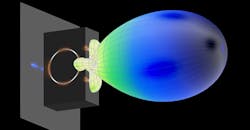As the popularity of wireless communications systems, such as WiMAX, continues to grow worldwide, antenna designers are faced with making components that are smaller but provide better reception than their older, larger predecessors. In quest of such a next-generation WiMAX antenna, Rajkishor Kumar, Sreenath Reddy Thummaluru, and Raghvendra Kumar Chaudhary from the Indian Institute of Technology in Dhanbad, India developed a dielectric resonator antenna (DRA) using a stair-shaped microstrip feed line, a rectangular dielectric resonator (DR), and a pair of L-shaped slots in the ground plane. The feed line enables the antenna to achieve wideband frequency coverage (2.94 to 3.85 GHz) with a circularly polarized (CP) radiation pattern.
The researchers followed a regimented, five-step design procedure to create the antenna. Slots in the ground plane were introduced as all antenna design parameters were kept constant by making modifications in the microstrip feed lines with the changes in the ground plane. In quest of a wide impedance bandwidth, several antenna designs were implemented until the target impedance bandwidth was achieved, modeling the amount of coupling between the DR and microstrip lines. Adding the L-shaped slot in the ground plane impacts the surface current density of the antenna design—parameters such as the height of the L-shaped slot affect the resonance mode on CP and the antenna’s ultimate frequency range.
While the mechanical adjustments made to this DRA may initially seem elaborate, the fabricated antenna design is less complex than many standard WiMAX antennas that were used for reference comparison. The new design provides a usable bandwidth of better than 17% at the center frequency with a single DR compared to other rectangular and comb-shaped antennas with more than one resonator, far less bandwidth, and very complex implementation. It’s also considerably smaller than the comparable WiMAX antenna designs, with better far-field parameters than the other reference antennas, for much improved WiMAX reception at greater distances.
See “Improvements in Wi-Max Reception,” IEEE Antennas & Propagation Magazine, Vol. 61, No. 1, February 2019, pp. 41-49.
About the Author
Jack Browne
Technical Contributor
Jack Browne, Technical Contributor, has worked in technical publishing for over 30 years. He managed the content and production of three technical journals while at the American Institute of Physics, including Medical Physics and the Journal of Vacuum Science & Technology. He has been a Publisher and Editor for Penton Media, started the firm’s Wireless Symposium & Exhibition trade show in 1993, and currently serves as Technical Contributor for that company's Microwaves & RF magazine. Browne, who holds a BS in Mathematics from City College of New York and BA degrees in English and Philosophy from Fordham University, is a member of the IEEE.

